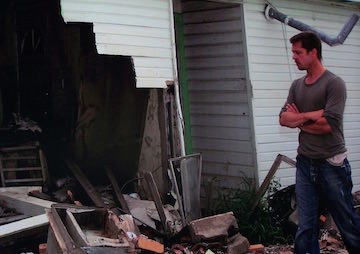What Happened After Brad Pitt and a Group of Star Architects Went to Rebuild New Orleans
In the wake of Hurricane Katrina, movie star Brad Pitt -- perhaps the city’s most famous resident -- established his Make It Right Foundation to rebuild the Lower Ninth Ward, one of New Orleans' poorest and hardest-hit neighborhoods. Attached to the project was a group of star architects including Frank Gehry, Thom Mayne and Shigeru Ban. Ten years after the storm, what have they achieved? An image of Brad Pitt from a Make It Right Foundation exhibition. (Casey at the Bat / CC BY-SA 2.0)
An image of Brad Pitt from a Make It Right Foundation exhibition. (Casey at the Bat / CC BY-SA 2.0)
In the wake of Hurricane Katrina, movie star Brad Pitt — perhaps the city’s most famous resident — established his Make It Right Foundation to rebuild the Lower Ninth Ward, one of New Orleans’ poorest and hardest-hit neighborhoods.
Attached to the project was a group of star architects including Frank Gehry, Thom Mayne and Shigeru Ban.
Ten years after the storm, a Washington Post article asks: What has all that talent achieved?
The answer, in the most basic sense, is that Brad Pitt’s Make It Right Foundation has built more than 100 houses, all equipped with solar panels and other eco-friendly flourishes, for families who otherwise might not have been able to afford a home. The group has plans to build at least 41 more, and in many blocks of the Lower Ninth, it is the only active builder.
But what the “starchitects” have achieved is considerably less. In fact, the vast majority of the homes built so far came from designs created by other, lesser-known architects that Pitt hired. In fact, none of those three most celebrated architects – Mayne, Ban and Gehry – can claim to have built any more than one prototype home out of the scores that have been built.
What happened? With the Mayne and Ban efforts, at least, the story is of the kind that gives contemporary architecture its aura of Alice-in-Wonderland elitism: the designs proved to be too clever to be built on a budget – that is, in reality. The two may be visionaries, but they appear to have fallen well short of what the Lower Ninth needed.
Construction costs in the Lower Ninth Ward, maybe even more than a typical location, is an important issue. It is a neighborhood of low- and moderate-income homeowners. Through special financing, the foundation seeks to ensure that homeowners don’t have to pay a mortgage above what their incomes can bear. The construction budget was $150,000. The visions of Ban and Mayne, apparently, couldn’t fit within that critical constraint.
The home design by Thom Mayne’s firm, Morphosis, did perform a neat architectural trick: the home can float, if necessary, in the next flood. But that feat depended on some pricey building technology.
Likewise, the home design by Shigeru Ban, a Japanese architect known for his “paper architecture” and working in disaster sites around the world, was distinguished by elegant interior walls, bearing built-in shelves made of maple plywood, officials said. Unfortunately, the carpentry didn’t come cheap.
The cost of building each of those surpassed the budget, foundation officials indicated, and if an architect wouldn’t revise the design to meet the goal, it did not move into general production.
“We had to keep in mind that these designs are for the people who will live here and not for the architects portfolios,” said Jordan Pollard, design manager for Make It Right. “If an architect is going to make a move on this budget, it has to be one move, and it has to be small – and architects tend to want to make 10 moves.”
Ban’s office did not respond to a request for comment.
Brandon Welling of Morphosis said that the Make It Right foundation proposed building a version of the house without the capability of floating but “we were resistant to that idea as it was not consistent with the urban or manufacturing goals of the project.”
He noted that “a number of the more conventionally built houses were eventually expanded in size, which likely made them more desirable for some homeowners.”
In the case of the prototype by Gehry, the designers came close to budget goals. He designed a duplex for which the budget goal is $300,000. The prototype came in at $350,000 and that’s close enough, foundation officials said, that it could easily move beyond prototype. So far, however, most of their clients have been looking for a single-family home.
“We could very likely build the Gehry house again if we find the right homeowner,” said Taylor Royle, a senior advisor to Make It Right.
As a result, the vast majority of the homes in the Lower Ninth Ward have been designed by architects without international renown, and several seem just as interesting…Indeed, the design most often selected by residents and built by the foundation came from a local architecture firm, Billes Partners. At least 17 copies of its home design have been built for Lower Ninth residents.
Indeed, the design most often selected by residents and built by the foundation came from a local architecture firm, Billes Partners. At least 17 copies of its home design have been built for Lower Ninth residents.
Read more here.
–Posted by Roisin Davis
With an uncertain future and a new administration casting doubt on press freedoms, the danger is clear: The truth is at risk.
Now is the time to give. Your tax-deductible support allows us to dig deeper, delivering fearless investigative reporting and analysis that exposes what’s really happening — without compromise.
Stand with our courageous journalists. Donate today to protect a free press, uphold democracy and unearth untold stories.








You need to be a supporter to comment.
There are currently no responses to this article.
Be the first to respond.